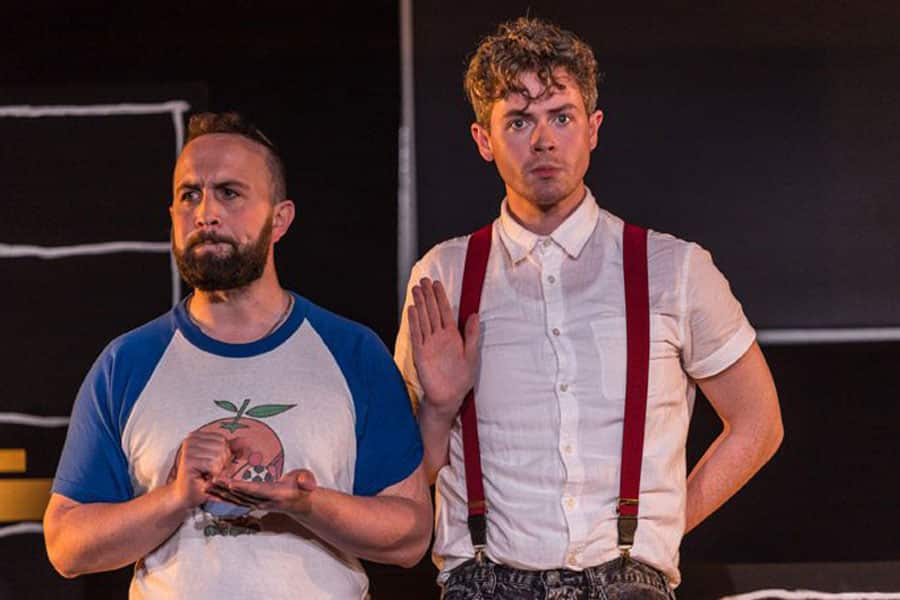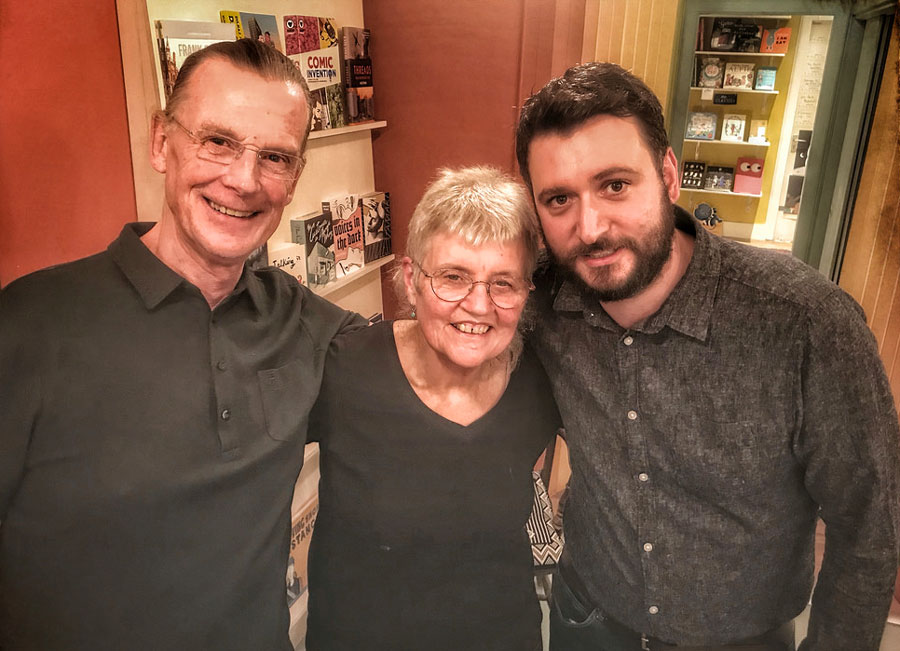While London’s Gays The Word bookshop is more in the public eye, (it featured heavily in the film Pride), less is known about Lavender Menace, the bookshop that began in the cloakroom of Scotland’s first gay nightclub and became the beating heart of Edinburgh’s LGBT community. Now celebrated as a play, Love Song to Lavender Menace performs at the Edinburgh Fringe Festival following a sell-out run at the Lyceum. Paul T. Davies caught up with Sigrid Neilson, co-founder of Lavender Menace, and the team behind the show.

I myself am just catching up with the history of Lavender Menace, so, for visitors to the Fringe, can you give me a brief outline of the history-maybe with one or two good anecdotes?
SIGRID NEILSON, CO-FOUNDER OF LAVENDER MENACE: The bookshop grew out of the fact that, for many LGBT people, including me, life in the sixties and seventies mostly had to be lived between book covers. These days you can see gay couples holding hands in Princes Street. In those days even trivial giveaways like this were taboo or even dangerous. One gay man said to me, ‘The only gay scene in Fife is on my bookshelves.’ Bob Orr, who had worked in bookselling, invited a group of us to take part in the SMG gay centre bookstall he’d started, and help the books reach more people. A few shelves of books – it was simple. But it was also a rollercoaster ride. Going public in those days was always controversial – there were different opinions about almost everything – and the Gay Centre tried to ban some of our books. We left and set up at Fire Island Disco – a huge cloakroom space where you could see your breath in winter and talk to ‘the bar dykes’ and gay disco lovers who would never go near a place with a sign on the door. The play tells you about the tiny entrance and drab stair of the disco in Princes Street, beside a sign which said ‘Watches of Switzerland’.
LGBT publishing was on our side – Rita Mae Brown, one of many new lesbian and gay writers, published the comic bestseller Rubyfruit Jungle – and took part in a demo where she and her fellow dykes shouted out, ‘We are the Lavender Menace and we are not going away!’ When we opened the shop in Forth Street in 1982, we named it after their action. Our sign was in full view. We were an ‘ordinary’ bookshop with LGBT romances, health and sex manuals, classics by Virginia Woolf and EM Forster, and everything on the shop’s ghetto blaster from disco cassettes to Radio 3 Evensong. Many people thought we’d be lucky to survive for six months – and the graph of our finances in those days went up and down like a mountain chain – but we kept going with the help and energy of the community and shop and mail order sales. The shop moved to larger street-level premises in 1987 – in one night, the night depicted in Love Song to Lavender Menace – and only closed its doors after 15 years.
The play takes the story much further – it’s still vital to say that we’re not going away, like the wild, weird, ordinary people we are.
How did you shape this history into a play, what were the inspiring/defining moments/stories? What is your personal connection to Lavender Menace?
JAMES LEY, PLAYWRIGHT: The defining moments were really the discovery of the existence of Lavender Menace itself. Before researching, I didn’t know it existed. Bob took me on a tour of Edinburgh, showing me some of the key locations relevant to the shops (Lavender Menace and West and Wilde, which I’d heard of) and we stood outside, what was once Lavender Menace. That moment I think I thought there might be a play.
Then when I discovered that Lavender Menace had started in the cloakroom of Fire Island nightclub – Scotland’s first gay club – I knew there was a play. Then I spent quite a lot of time with Bob, Sigrid and other key people in the life of Lavender Menace and West and Wilde and the play really grew out of those conversations and getting into the history and the story of the how the shop happened.
My personal connection is that I now know and love and admire the founders and I’ve discovered the shop and that whole world through them. They’ve invited me to reunions and I feel like an honorary Lavender Menace member. Sometimes, when I remember I haven’t ever been there, I can’t quite believe it. I also now know that it’s a huge part of LGBT liberation in Scotland and I feel like a lifelong champion of that.

I’m old enough to believe that the 1980s were a golden decade of music! This is a Love Song to Lavender Menace – does music feature, and, if so, what’s the soundtrack?
ROS PHILIPS, DIRECTOR: Yes, you bet there’s music! Communards, Communards, Communards, Village People, Hi-NRG, Communards, Mel and Kim, Communards, and much, much more. James has woven lyrics into the show so you can play 80’s disco bingo and laugh, cry and sing along all at the same time.
The Lyceum run was very well received- did that surprise you? What response particularly touched you? Have you reworked the play since the initial run?
JAMES LEY: Yes and no. Yes, because it’s an Edinburgh story and it’s our history and I always wanted it to get that kind of recognition and one of my aims was for Bob and Sigrid to get the recognition they deserve. No, because it was the first ever Lyceum Studio production, it was in October, not the fringe, and I never expected us to sell out. it was a wonderful surprise to sell out, increase the house-size and to get great reviews and word of mouth, and moving reactions. We have reworked it. It’s been really reduced in length for the Fringe. We’ve tried to keep the heart of it, but it was 2 hours and 5 minutes before, and it’s not 75 minutes. So it’s been on a bit of a diet!
ROS: We’ve had to cut the show right down for the Fringe, which has been an excellent exercise in cutting to the chase. It’s a painful but wonderful process of boiling the piece down to its essences. To be honest, the 80’s was not a great time to grow up; the threat of nuclear war, Thatcherism, my dad being made redundant, my mum -a teacher- having her work denigrated – I wasn’t a fan and, to make matters worse, I hated Duran Duran. This show has re-introduced me to the alternative 80’s and the amazing culture, humour and determination people had. To meet Bob and Sigrid and get to know the intricacies of making the bookshop work against that backdrop has reignited me. Once the show opened, a whole community re-found each other. That’s been a glorious thing to watch.
What are your hopes for the play post-Fringe?
JAMES LEY: I just want the play to keep happening and for everyone to know the story of Scotland’s LGBT liberation. There are lots of countries and cities around the world who need to hear this story, as they might be facing all sorts of oppression. I want this story to inspire them. And I want us to know our history for all time. So purely altruistically (ha) I want the play to tour and keep being performed. I’m also working on the screenplay… I’d love to tour the play and to countries where people really need to see it too.
Finally- what are your tips for surviving the Festival?
JAMES LEY: Drink lots of water. Sleep all day on Mondays. Be kind to each other and cross-promote other shows. And also to remember, we’re so lucky to be in the biggest arts festival in the world – we should be grateful and enjoy our freedom of speech and artistic expression. And always remember you can sleep in September.
ROS: Dive in, splash about, make memories.
BOOK TICKETS TO LOVE SONG TO LAVENDER MENACE
More news on the Edinburgh Fringe 2018
